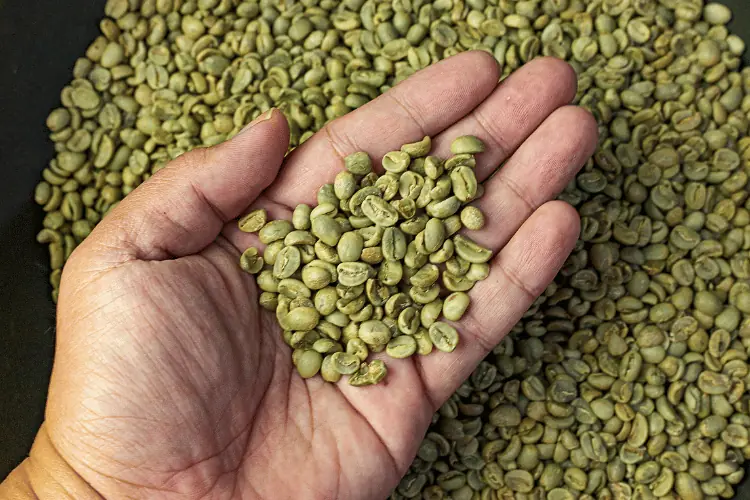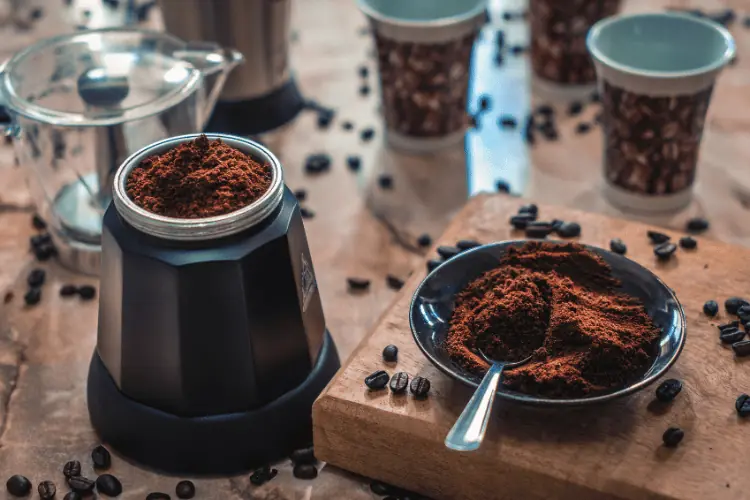There’s a comforting ritual in preparing a cup of fresh coffee. A familiar dance of fragrant beans, hot water, and anticipation. Yet, what happens when this symphony of scents takes an unexpected turn, and your coffee smells like tuna?
Such a peculiar puzzle has confused coffee enthusiasts around the globe. In this journey, we embark on a quest to unravel this mystery. So, come along as we dig into the world of coffee science and storage tricks to figure out why your coffee might take on that fishy aroma.
Reasons Why Coffee May Smell Like Tuna
Have you ever experienced your morning coffee taking on unexpected scents? From fishy to urine smells, this happens more than you think.
In fact, such an occurrence can have more than one explanation. Check out a few reasons why your cup of coffee has a fishy smell.
A. Immature Green Beans
When green coffee beans are in their early stages, much like green bananas, they impart a fishy aroma to your cup.
If these green beans aren’t fully mature during the roasting process, a chemical reaction occurs. Consequently, this contributes to an unexpected tuna smell in your brew.
B. The Oxidation Process
Picture your coffee beans taking a nap in storage. Sometimes, they get a bit too much air, just like an apple turning brown when left out.
Such a process, called oxidation, can transform the pleasant aroma of your coffee. If it leans towards the tuna side, it might be due air exposure during its resting period.
C. Coffee Beans’ Hygroscopic Nature
Coffee beans have a fondness for moisture. If they soak up too much moisture from the environment, it can create a fishy odor.
It’s a delicate balance. Primarily, enough moisture is excellent for a flavorful brew. However, too much of it might lead to that unexpected tuna aroma.
D. Improper Storage
Imagine leaving your favorite snacks open and exposed. Over time, they lose their freshness and might not taste the same. Coffee is no different.
If not stored properly, coffee can lose its delightful aroma and take on a fishy smell. Therefore, proper storage is a must. It’s like keeping those snacks in a sealed bag to maintain their original flavor.
E. Unclean Equipment
If you don’t keep your coffee gear clean, your brew might pick up unwanted flavors, including that unexpected hint of tuna fish. Thus, keeping your coffee-making equipment clean ensures that your coffee stays fresh and delightful.
Ideally, regular cleaning prevents lingering tastes from impacting the pure and rich aroma of coffee.
How To Identify Mature Coffee Beans
Identifying mature, well-roasted coffee beans involves considering various factors related to their appearance, aroma, and source.
Here are some tips to help you recognize high-quality, perfectly roasted coffee beans:
- Color: Look for coffee beans with a rich, deep brown color. In general, well-roasted beans often have a shiny surface due to natural oils.
- Uniformity: Seek beans that display consistent color, avoiding uneven patches or signs of scorching.
- Fragrance: Freshly roasted coffee beans emit a strong and inviting fragrance. So, prioritize beans with a pleasant and robust aroma.
- Freshness Date: Check for a freshness date on the packaging, typically labeled with a roasting date for well-roasted beans.
- Packaging: Choose beans stored in airtight packaging with one-way valves, preserving freshness.
- Crack Stage: Well-roasted beans go through the first and second cracks during the roasting process, contributing to flavor development.
- Single Origin: Opt for single-origin coffee beans to explore unique flavors from specific regions.
- Reputable Sources: Support local roasters who prioritize quality sourcing and roasting practices. Alternatively, opt for well-known brands committed to delivering high-quality coffee.
How To Store Coffee Beans Properly
Ensuring correct storage techniques for your coffee beans and coffee grounds is vital for preserving their delightful aromas and flavors.
Here’s a simple guide to help you keep your coffee beans fresh and free from unwanted odors:
1. Using Airtight Containers
As previously mentioned, coffee beans have a hygroscopic nature, meaning they absorb moisture from the environment. Conveniently, airtight containers prevent excessive moisture absorption, preserving the beans’ freshness.
All you need to do is transfer your coffee beans to a sealed, airtight container. Doing so shields them from external odors and maintains their hygroscopic balance.
2. Storing in Cool, Dark Spaces
Generally, exposure to heat and sunlight accelerates the aging process of coffee beans. As such, storing them in a cool, dark place helps maintain their quality over time.
Therefore, you need to choose a cupboard or pantry away from direct sunlight and heat sources. You should also try to keep the storage area consistently cool.
3. Avoiding Excess Air
Coffee beans can undergo oxidation when exposed to too much air, affecting their aroma and flavor. Thus, minimizing air contact helps retain their freshness. So, when closing the container, you may need to press out excess air before sealing.
It helps to consider using vacuum-sealed containers as an extra layer of protection.
4. Keeping Away From Strong Odors
Just like sponges, coffee beans readily absorb surrounding odors. That’s why storing them away from strong-smelling items is necessary. Doing that ensures they maintain their unique and desirable aroma.
For best results, keep your coffee away from any smell-emitting kitchen items. This includes spices, strong cheeses, or other pungent items that could impart unwanted scents.
4. Maintaining Whole Beans Until Brewing
Grinding coffee beans accelerates the release of coffee oils, making them more susceptible to oxidation and flavor loss. Consequently, you should consider grinding just before brewing to preserve the beans’ essence.
To do so, you may think about investing in a good-quality grinder and grind your beans just before brewing. This ensures a fresh and aromatic cup every time.
5. Performing Regular Checkups
As an extra measure, you should keep an eye on your stored coffee beans. Principally, monitoring their condition helps you catch any signs of staleness or unwanted odors early on.
Ideally, you should check your coffee beans for any changes in aroma or appearance now and then. If they lose their freshness, it might be time for a new batch.
Tips for Cleaning Coffee-Making Equipment
Maintaining clean coffee-making equipment is essential to ensure your brew stays free from unwanted odors and flavors.
Follow these straightforward steps to keep your gear in top-notch condition:
1. Have a Regular Cleaning Routine
Unclean equipment can impact the flavor and aroma of your coffee. That’s why establishing a regular cleaning routine is highly recommended. Most importantly, it prevents the buildup of residues that may contribute to off-putting smells.
Although it might seem like a lot to do, it pays off in the long run. So, don’t ignore washing all removable parts of your coffee maker after each use with soapy, warm water. This includes the carafe, filter basket, and any detachable components.
2. Use White Vinegar
White vinegar is an excellent natural cleaner that helps eliminate any lingering odors, residues, or scaling. Furthermore, it’s widely available in all houses.
Optimally, you just need to run a mixture of equal parts white vinegar and water through your coffee maker. Following this, run a few cycles of plain water and ensure to rinse any vinegar residue thoroughly.
3. Clean the Coffee Grinder
Just like other coffee equipment, the coffee grinder can retain oils and particles from previous grinds. As a result, this affects the freshness of your beans. Therefore, you need to clean it as part of your routine as well.
To do so, disassemble your grinder and clean its components with a brush or a slightly damp cloth. Before reassembling, ensure all parts are completely dry.
4. Inspect Your Coffee Maker
Coffee oils can accumulate in various parts of your coffee maker over time, contributing to fishy smells. To avoid that, you must inspect and clean it from time to time.
Mainly, try to clean areas where coffee oils may collect, such as the brewing chamber and the coffee spout. For specific cleaning instructions, follow the manufacturer’s guidelines provided with the packaging.
5. Pay Attention to Filters
As well as other parts, coffee oils and particles can accumulate in paper or metal filters. When this happens, it affects the taste and aroma of your brew.
So, make sure to replace disposable filters regularly. Additionally, thoroughly clean reusable filters after each use. As for metal filters, a soak in a solution of white vinegar and water can help remove stubborn residues.
6. Leave Parts To Dry Completely
For the final step, ensure all parts are thoroughly dried before reassembling. Besides that, leave the lid of the coffee maker or the grinder’s hopper open to allow proper ventilation.
Otherwise, dampness can lead to the growth of mold and mildew. As a result, this may lead to unwanted smells emitting from your equipment.
Final Thoughts
A few factors can contribute to why your coffee smells like tuna, from unclean tools to immature coffee beans. By understanding these elements and taking simple steps, you can reclaim the pure, delightful aroma of your coffee.
Just remember to keep your beans fresh, and your equipment clean to enjoy a cup free from unexpected odors. Here’s to savoring every sip of your coffee without any lingering tuna surprises! Happy brewing coffee lovers!












